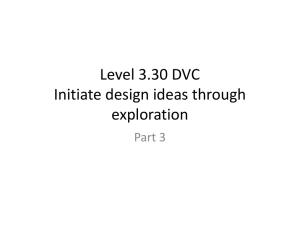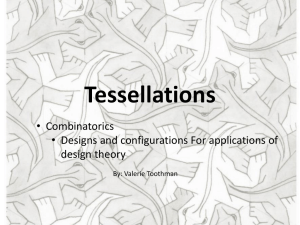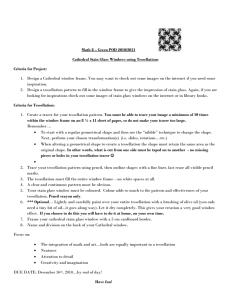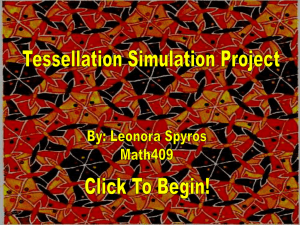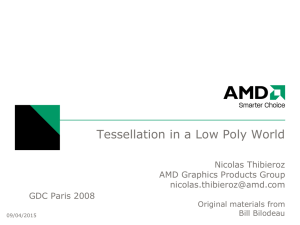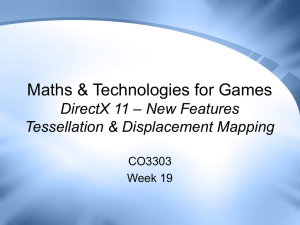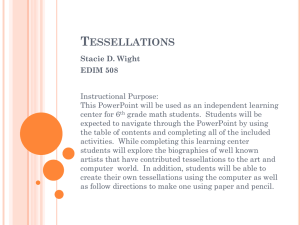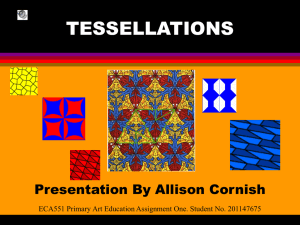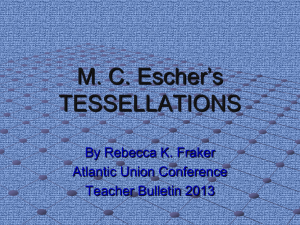GPU Tessellation
advertisement
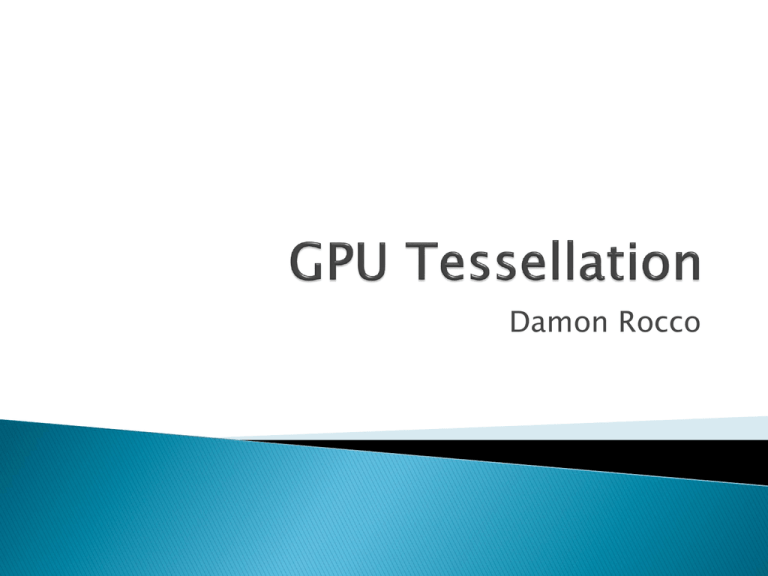
Damon Rocco Tessellation: The filling of a plane with polygons such that there is no overlap or gap. In computer graphics objects are rendered as a triangular mesh ◦ A triangle is always a plane Thus, the triangles in a mesh can be tessellated to increase detail In software tessellation provides an interesting way of enhancing detail In hardware tessellation allows a simple mesh to be sent down to the GPU, converted to a complex mesh, and then displayed ◦ Decrease memory to the card ◦ Increase rendering performance by decreasing the number of polygons through the full pipeline With programmable tessellation what objects get tessellated can be decided by the programmer This allows for objects closer to the screen to be tessellated while objects far away are not ◦ Detail actually increases as objects get closer instead of just getting bigger ◦ Resources aren’t wasted on meshes that are too far away for tessellation effects to be viewed Xbox 360: ATI Xenos graphics chipset ◦ The first geometry tessellation unit ◦ “Programmable” ATI Radeon HD 5xxx series ◦ The first DX11 card NVIDIA “Fermi” ◦ NVIDIA’s first DX11 card DirectX 9: Dynamic Terrain Rendering on GPU Using Real-Time Tessellation. Natalya Tatarchuk. ATI Research published in ShaderX7 DirectX 10: Instanced Tessellation in DirectX10. Andrei Tatarinov. GDC ‘08 DirectX 11: New pipeline features three tessellation stages, 2 are programmable Natalya Tatarchuk Goal: Create a software library that would allow tessellation exclusively on ATI cards. Product: ATI GPU Tessellation library. An ATI only library that worked in conjunction with DirectX 9 (also 10.x) and was capable of tessellating meshes A flat 900 polygon grid becomes a 1,000,000 polygon mountain-scape at inter-actable rates Andrei Tatarinov In the past complex shading models were used to hide lack of detail in a polygonal mesh They can only do so much… The solution is to use on-the-card tessellation to increase the physical detail in the meshes A highly detailed mesh can be sent to the card as a simple mesh and a displacement map Trades ALU operations for memory bandwidth ALUs scale faster than bandwidth Tessellation can also be used by Animators to make their job easier ◦ Animate a low polygon mesh ◦ Tessellate and get detail for free New “patch” primitive defined by a set of control points Operation called refinement generates triangle from each patch Per-patch operations ◦ Level of Detail computation ◦ Transfer of Basis Bezier -> B-spline B-spline -> NURBS Etc. Generating topology ◦ Generates a set of (u,v)-points in the tessellation domain Programmable hardware tessellation ◦ 3 stages 2 programmable shaders 1 fixed function configurable tessellator ◦ New primitive “patch” Curved surface Easily converted to triangles Programmable tessellation can be imitated using DirectX 10 features: ◦ Geometry Shader and Instancing 2.0 Geometry Shader cannot do tessellation itself ◦ Outputs triangles serially ◦ Maximum output size of 1024 scalars 16x16 grid of float4s Instead we can save small pre-tessellated patches as instances The pre-tessellated patches represent the results of tessellating every input patch This data is combined in the vertex shader to produce the desired effects Vertex shader inputs are too small to handle an entire mesh ◦ Must be bound to shared buffers The tessellation mesh instances are of varying quality, a LoD factor is used to determine which mesh to select Tessellation factors can change across a mesh as each patch edge has its own tessFactor. Per-patch tessellation factors requires multiple draw calls (it won’t in DX11) Since all of the meshes are stored in vertex buffers the only inputs are the primitive id and the vertex id U = Vertex ID mod LoD V = Vertex ID div LoD LoD is based on vertex position Mesh: 6118 patches, 256 vertices each, 8800 GT Tessellation presents a means of significantly increasing detail without a performance cost Tessellation is possible with DirectX 10 Some of the hiccups with the DirectX 10 implementation will be fixed by future hardware implementations Kevin Gee D3D11 HW Feature ◦ Required for DirectX 11 compatibility D3D11 Only ◦ No direct backwards compatibility Fundamental primitive is “patch” ◦ Not triangles Superset of Xbox 360 tessellation 3 new stages added for Tessellation Programmable Takes patch control points as an input 2 Output paths: ◦ Output of basis converted control points to Domain Shader ◦ Output of the control points, a tessellation factor, and tessellation modes to the Tessallator Tessellator operates on a per patch basis Again 2 output paths: ◦ Outputs U,V points to Domain Shader for further shading ◦ Outputs topology for primitive assembly Either receives a set of points from the Hull Shader or the Tessellator. The Domain Shader is invoked once per point It outputs verticies Images courtesy of ATI Creates a new authoring pipeline ◦ 1-pass process from input to optimally tessellated mesh ◦ Makes both animation and real-time applications faster ◦ Allows for a higher level of detail Images courtesy of NVIDIA Gamefest 2008 Ignacio Castano Tessellation lets us send down low polygon meshes to save memory and bandwidth which are the main bottlenecks Tessellation allows for view dependent levels of detail so the GPU doesn’t waste time rendering unseen triangles. Subdivision Surfaces are a well explored technique for increasing the detail of a mesh. Previous GPU implementations required multiple GPU passes The new DirectX 11 tessellation hardware allows us to do subdivision surfaces in a single pass The hull shader is used for control point evaluation. Input is a face and its neighboorhood Output is a regular bicubic bezier patch of the face The Domain Shader evaluates the bicubic Bezier patches and corresponding tangents Reorders face patches for consistent adjacency Requires 69 instructions TATARCHUK N.: Dynamic Terrain Rendering on GPU Using Real-Time Tessellation. ShaderX7 (Dec. 2008). Tatarinov, A.: Instanced Tessellation in DirectX10. GDC 2008. February 2008. Gee, K.: Introduction to the Direct3D 11 Graphics Pipeline. Nvision 2008. Castano, I.: Tessellation of Displaced Subdivision Surfaces in DX11. Gamefest 2008

